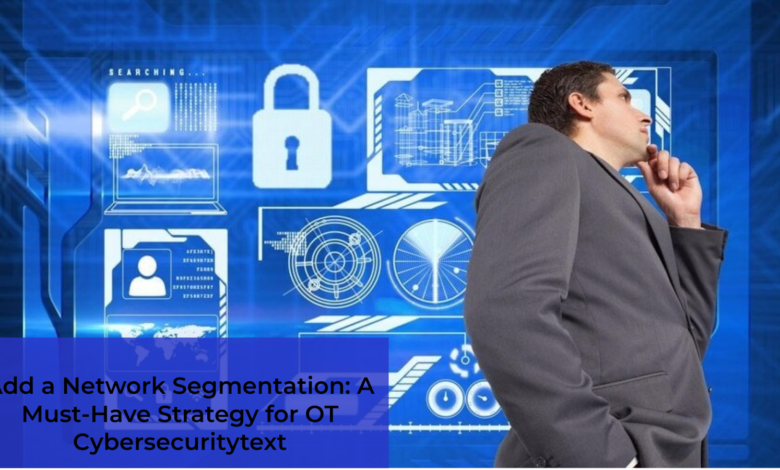Network Segmentation: A Must-Have Strategy for OT Cybersecurity

Operational technology systems have become quite essential to most industries involved in manufacturing. Energy production, transportation, and utility provision. These are systems in charge of and monitoring all the physical processes and infrastructure in a facility. Whether managing an assembly line or a power grid, as these OT environments increase their interconnection with the IT systems and the external networks. They also increase vulnerability to cyber threats. It is within this context that network segmentation becomes essential in cybersecurity.
Network segmentation is the act of dividing a network into smaller. Isolated segments or subnets. This allows control and limits communication between parts of the network. Making it more secure, performative, and compliant. For OT environments, network segmentation has become no longer a best practice. But an essential approach to protect critical assets. Against cyber-attacks and limit the risk of a system-wide compromise.
Best Practices for Implementing Network Segmentation in OT Environments
Define Clear Security Zones
You must group all your OT network resources. Taking into consideration critical assets. Into zones by defining their criticality to categorize them in general – one zone. Comprising systems with the highest rank on criticality. The others such as administrative, or corporate, those that are considered as non-sensitive. This can help to define certain zones that could be targeted by security controls. So, protecting the most sensitive systems with the best defenses. A cybersecurity guide would provide very helpful information. About how to categorize assets and define these zones effectively.
Put in place Strong Perimeter Defenses
Firewalls, IDS, and IPS must be implemented at the boundaries of network segments. This is where all the devices would be useful as they help prevent unauthorized access. Between the segments while tracking traffic that indicates malicious behavior. Ensure that your security measures follow the needs of the respective zones. And thus ensure proper levels of protection for the same.
Apply Least-Privilege Access Controls
User and device access should be kept to a least of only the necessity level for the role. One benefit of least privilege is reduced risk from insider threats. Or accidental misconfigurations of systems by users and devices since they can have access only to the level of systems. That are used to accomplish their work tasks. Implementing RBAC and having permissions reviewed. Over a given time will support secure network segmentation.
Segment OT and IT Networks
Segment the OT and IT environment. One of the most fundamental aspects of network segmentation. OT systems run typically over much older or highly specialized protocols. That are less secure when compared to the more current IT systems. Isolation will be reduced when keeping both networks separate. It’ll further cut the spread of an attack on the cyber attack side to the OT-critical systems. You do this by isolating firewalls and DMZs. Which can then ensure these networks still allow essential communication between them.
Track and Maintain Segmentation
Continuous monitoring of network traffic is required. To ensure the effectiveness of segmentation over time. Regular audits are so necessary to verify. Whether there is adherence to access control policies. And whether there have been no unauthorized changes to the network segmentation. Also, ensure that there is an incident response plan clearly outlining how to respond to a security breach. Involving network segmentation. For further information on how to track best practices. A cybersecurity guide can provide more technical methods. And tools to better your approach.
Best Practices for Implementing Network Segmentation in OT Environments
Define Clear Security Zones
Begin by structuring your OT network as security zones. For instance, you can separate the most critical systems and data into a zone. And the less sensitive systems, like administrative or corporate networks, into another zone. Once you categorize your network into those zones. You can impose specific security controls on the different zones. For instance, you will be sure that the most sensitive system is protected by stronger defense mechanisms.
Implement Strong Perimeter Defenses
Ensure there is protection of the firewalls. Intrusion detection systems (IDS) and intrusion prevention systems (IPS) should protect the boundaries between network segments. These devices can detect signs of malicious activity crossing or between segments and block such unauthorized access. Security measure deployment should be aligned according to the needs. Of a specific security zone and provide protection.
Apply Least-Privilege Access Controls
It has the effect of limiting users. And devices to access a least necessary for their specific roles. The principle of least privilege reduces the risk that any form of insider threat might be caused. By an unintentional misconfiguration by controlling users and devices about access. To the system. Implementing RBAC and ensuring that permissions are regularly reviewed. Can help a secure network segmentation strategy maintain its integrity.
Segment OT and IT Networks
One of the most crucial factors related to network segmentation. Is that the OT and IT environments are split. OT devices work often with older or specially used protocols not as strong. Compared to more modern IT systems. When these are kept separately. There’s a much less chance for a cyberattack to begin with the IT side. Spreading towards more critical OT devices. Make use of firewalls and DMZs for segregation while. Also facilitating all communications between such isolated networks.
Track and Maintain Segmentation
Network traffic must be continuously monitored. To ensure that segmentation continues to be effective over time. Regular audits should be performed to confirm that access control policies. Are being followed and that no unauthorized changes have occurred. To the network segmentation. An incident response plan also should be maintained. That clearly outlines how to respond in the event of a security breach. Involving network segmentation.
FAQs
1. How can network segmentation help with compliance requirements for OT systems?
Network segmentation helps meet regulatory standards by isolating critical OT systems. And reducing unauthorized access. It supports compliance with regulations. Like NIST and NERC-CIP, which require secure network boundaries and monitoring.
2. What are the challenges of implementing network segmentation in OT environments?
Challenges include integrating legacy OT systems with modern security protocols, resource-intensive management, and ensuring minimal disruption to operations during implementation.
3. Can network segmentation prevent all types of cyber-attacks in OT environments?
No, while network segmentation improves security, it doesn’t prevent all attacks. It should be part of a broader strategy that includes endpoint protection, monitoring, and vulnerability management.
Conclusion
The practice of network segmentation is indeed. A highly potent cybersecurity practice in protecting and hardening OT environments significantly. At its heart lies an old truth in protecting critical infrastructure. It is more than just old-school IT security these days to fight evolving cyber threats. By isolating sensitive OT systems, reducing attack surfaces, enforcing access control policies, and achieving regulatory compliance, network segmentation becomes a critical defense mechanism. Network segmentation is essential in securing the OT systems from very potent cyberattacks.
In a world where cyber incidents in OT environments have consequences. That can be catastrophic. Taking up network segmentation is no longer a best practice. It is a must-have for any organization that cares for the protectio. Of its critical infrastructure. And ensuring the continuity and safety of operations.




